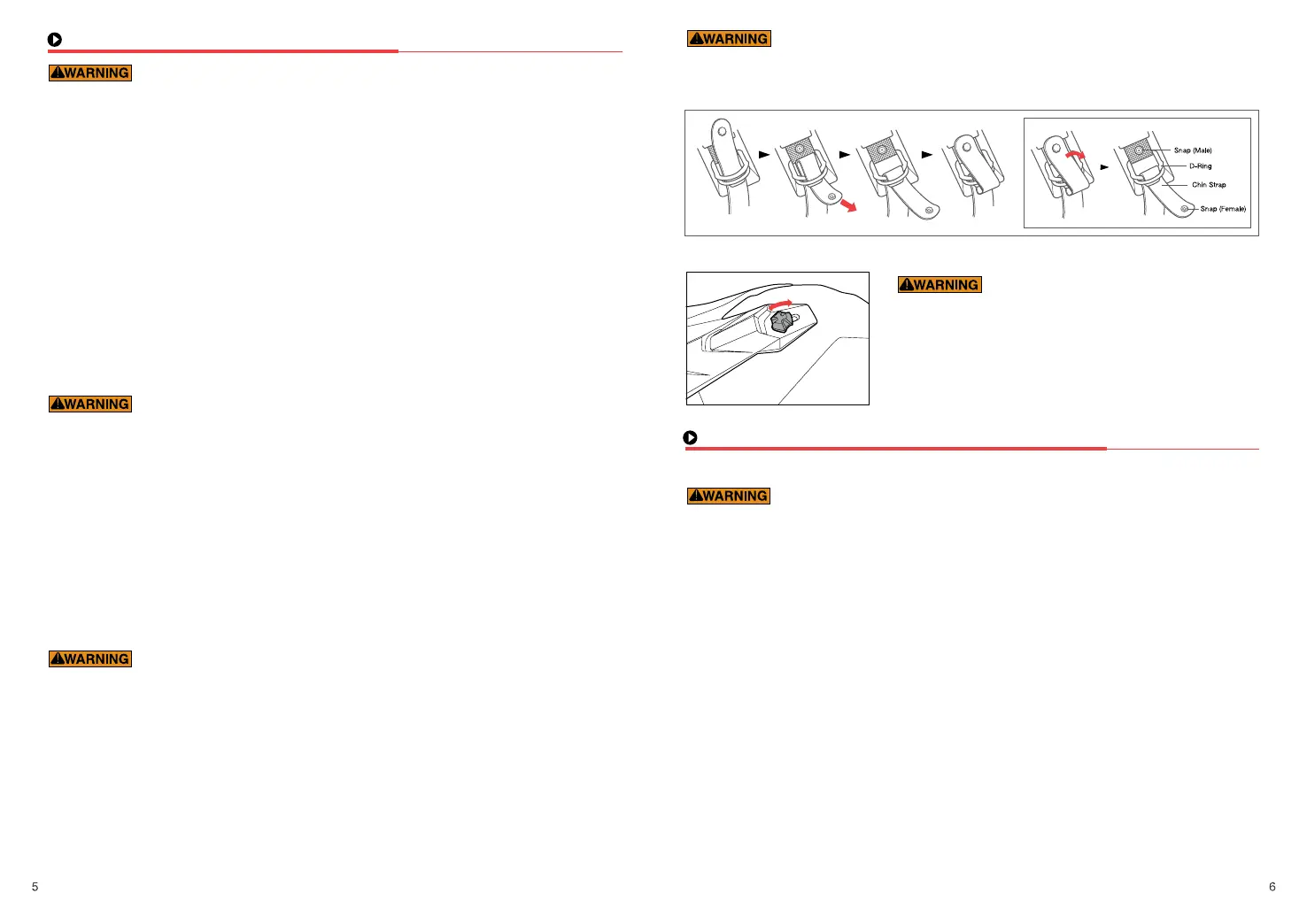Using Your Helmet Correctly
● Never adjust your helmet accessories while riding – Only make helmet adjustments when stopped.
● Never drop your helmet – Dropping your helmet may crack the shell or damage the protective foam.
The damage may not be visible. Your helmet is only designed for ONE impact. Refer to “Helmet
Replacement” (p.10) for more information on what to do after helmet has been dropped.
● Never wear anything between your head and your helmet – this may reduce the effectiveness
of your helmet.
● Never hang or hook your helmet on anything including handle bars - Doing so may
cause damage to the helmet protective foam or liner.
● Never use insect repellent on or around your helmet – insect repellant may damage your
helmet’s visor, shell, protective foam, or other components.
● Never expose helmet to gasoline or gasoline fumes – Gasoline may damage your helmet’s
visor, shell, protective foam, or other components.
● Always wear eye protection – Always wear eye protection when riding.
● Always be alert for sounds – Your helmet may impair your hearing. However, your helmet is not
a form of hearing protection.
● Always store your helmet in its helmet bag when not in use to help reduce accidental surface damage.
To reduce the risk of serious injury or death and to help prevent damage to your helmet :
To reduce the risk of serious injury or death, always use your helmet correctly.
If parts fall off while riding, your vision may be blocked which could cause an accident.
Inspect your helmet
To ensure that your helmet is in the best condition to maximize your protection, always inspect
your helmet for damage before riding :
● Check visor screws – retighten if necessary. Be sure not to over-tighten any screws. Center
screw can break and visor screws can strip the screw sleeves if over-tightened.
● Check for helmet damage. – If your helmet is damaged or cracked, stop using it immediately.
See “Helmet Replacement” (p.10) section for further information.
If your helmet has been dropped, you may not be able to see the damage.
● Check for worn or damaged parts. Plastic components may wear out over time.
If you find worn or damaged parts, replace them or purchase a new helmet.
See “Replacement Parts” (p.9) for information on parts replacement.
● Check the retention system (chin strap) for damage. If it is frayed or ripped, replace the helmet.
● Check that all pads are in place. Both of the cheek pads and the crown pads must be in place.
Fasten the Retention System
Fasten the retention system (chin strap) as tight as possible under your jaw without causing pain.
There must be no slack in the strap, and the strap must be snug up against your jaw.
If the retention system is not tight, your helmet may become dislodged or knocked off in an accident.
Do not rely on the snap to secure the helmet. The snap is provided only to prevent the
strap from flapping in the air. Fasten the retention system only in the following manner:
Visor adjustment is critical to ensure a full range
of vision. HJC recommends adjusting the visor to
its highest position, lowering it only when riding
in muddy conditions to offer better “roost”
protection. (DO NOT over tighten the side or
center adjustment screws).
Double “D” Ring
Visor Adjustment
Maintaining Your Helmet Correctly
Only use approved methods to clean the helmet. Using other unapproved chemicals or
methods may damage the helmet shell or lining. A damaged helmet may increase your
risk of serious injury or death in an accident.
Glossy Finish. HJC recommends cleaning your helmet with products designed for automotive
cleaning and polishing. All HJC helmets are finished with an automotive type base coat/clear coat
finish. Rubbing compounds can be used for deep cleaning to remove many scratches and scuffs.
Follow the product’s instructions diligently. Over polishing with rubbing compounds can cause
light abrasions which may dull the finish of your helmet. Stickers and decals will leave adhesive
residue when removed. To remove the adhesive residue, use alcohol swabs. Be certain to
immediately wipe away the excess liquid and clean the area with soap and water once the
adhesive residue is removed. Do not use excessive pressure while rubbing when attempting to
remove the adhesive residue, instead use multiple light treatments.
Non-Glossy Finish. For our flat finish (non-glossy) helmets, we recommend using warm water and mild
soap. Use multiple treatments for heavier dirt. Do not use excessive pressure or rubbing compounds
while cleaning the surface as a “glossy” effect could be created, running the flat finish appearance.
Shell Cleaning
1. Please clean helmets from dust, bugs or grass within one day.
Cleaning progress
1) Clean the helmet with warm water and cloth.
2) If there are any remains left, dry the helmet and remove any remaining contamination with rubber
eraser.
※ Do not use any alcohol or thinner to clean the helmet because they may damage the paint.
2. Avoid oil contamination as it is extremely difficult to clean once exposed.
■

